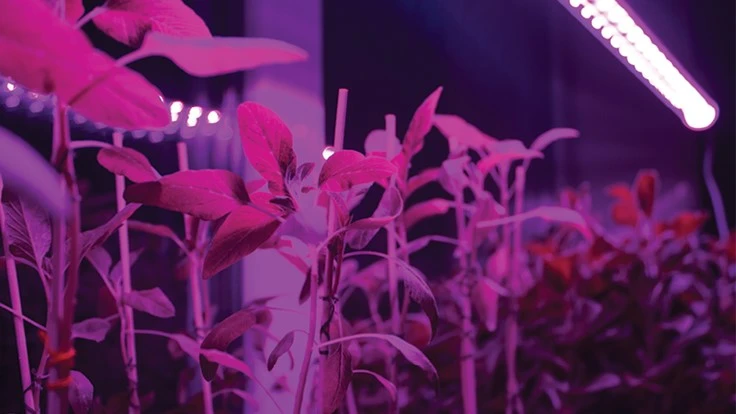

Editor's Note: This article is part of Cannabis Business Times' 2019 "State of the Cannabis Lighting Market" report, published in the November 2019 issue of CBT and supported by Fluence.
For nearly 50 years, scientists and horticulturists have accepted that wavelengths of light used in photosynthesis are limited to a range of 400 to 700 nanometers. This definition of photosynthetically active radiation (PAR) was solidified in the early 1970s with the publication of Dr. Keith McCree’s McCree Curve.
Now, thanks to decades of research at Utah State University’s Crop Physiology Laboratory, a new understanding of PAR has emerged.
Led by director Bruce Bugbee, professor in the Department of Plants, Soils and Climate, USU research is redefining PAR and transforming scientific understanding of light quality, commonly thought of as ratios of color.
Well-known for his pioneering NASA-supported research on crops in space, Bugbee has studied spectral effects on photosynthesis and plant morphology for 40 years.
Despite McCree’s place in science, Bugbee says USU research provides evidence of photosynthesis from photons beyond the 700 nanometer limit of the McCree Curve.
Shifting the discussion surrounding light quality
As a first step toward understanding Bugbee’s research, he stresses the importance of separating the effects of light quality into effects on photosynthesis versus effects on plant shape.
Bugbee says there's an unwarranted emphasis on red/blue or narrow-band light for photosynthesis. As a result, narrow-band light became popular in LEDs, negating the power of the entire spectra of light. “The effect of color on photosynthesis is way overrated,” he says. “Conversely, the effect of color on plant shape is underrated.”
He explains that light quality has only a small effect on photosynthesis, but a large effect on plant shape. And the effect of light quality on plant shape varies widely among species.
Bugbee hopes to shift the conversation on the effects of color ratios away from photosynthesis and toward plant shape and secondary metabolism.
Regarding photosynthetic effects, he points to light intensity (aka light quantity). “Photosynthesis is exquisitely sensitive to intensity,” he says.
Leveraging technological advances
At the time of McCree’s work, technology for studying spectral effects was primitive by modern standards. “As great a scientist as McCree was, and I knew him personally, he didn’t have LEDs,” Bugbee says.
Bugbee equates the advent of LED (light-emitting diode) technology to the development of the telescope for studying astronomy. “There are lots of examples in the history of science of major breakthroughs in measurement technology that allowed scientists to test new things,” he says. “LEDs are like that for plant photobiology.”
With these technological advances, the USU team has evidence that photosynthetic photons extend beyond 400 to 700. As an example, Bugbee points to far-red photons, barely visible to the human eye at 730. By themselves, they do nothing, he says, but synergism occurs when combined with other wavelengths.
“In addition to photosynthesis, far-red photons are a powerful tool to manipulate plant shape,” Bugbee says. In lettuce, they cause plants to grow wider with larger leaves. But unfortunately, most other plants respond to far-red with excessive stem elongation, he says.
_fmt.png)
Modifying the definition of PAR
Bugbee hesitates to claim he’s redefined PAR, but he says the manuscripts currently in review in peer-reviewed scientific journals suggest a new definition. Until accepted for publication, the papers remain confidential, but he believes they have the potential to be as profound as the McCree paper 50 years ago.
“If we start getting people to think about an expanded range of wavelengths for photosynthesis, that’s a big deal,” he says. “We are not yet sure how much it should be expanded, but it may be as much as 350 to 750.”
Focusing on light efficiency
Bugbee advises growers to stop worrying about colors and concentrate on efficiency.
As a benchmark, Bugbee says high-pressure sodium lights put out 1.7 micromoles per joule, similar to LEDs five years ago. Today's LEDs now run from an efficacy of 2.6 to 3.1 micromoles per joule, and the technology is still maturing.
He recommends growers consult the DesignLights Consortium website, designlights.org. The nonprofit lists the photosynthetic photon efficacy (PPE) of fixtures based on third-party testing. “PPE is an important metric for growers when selecting lights,” Bugbee says.
“After selecting an effective fixture (micromoles per joule), the fractions of blue and far-red photons can be fine-tuned to alter plant shape,” he says.
Moving forward with new understanding
As Bugbee’s research continues, he says two issues remain center stage.
While well-aware of the commercial implications of the research, Bugbee says that’s not foremost in his mind.
“We’re more interested in elucidating fundamental plant-growth responses to light and the definition of photosynthetic photons,” he says. “We’re re-examining our understanding of some fundamental principles. This thing we thought we had exactly right for 50 years, now we’re saying that wasn’t exactly right.”

Explore the November 2019 Issue
Check out more from this issue and find your next story to read.
Latest from Greenhouse Management
- Terra Nova releases new echinacea variety, 'Fringe Festival'
- AmericanHort expands greenhouse training with new Section Grower Certification
- Sakata Seed America celebrates renovation of Cal Poly greenhouse complex
- American Horticultural Society names winners of 2025 AHS Book Awards
- Nufarm announces unified brand
- American Horticultural Society announces winners of 2025 Great American Gardeners Awards
- What growers can learn from amateur plant scientists
- Green Guide: Monarda punctata





